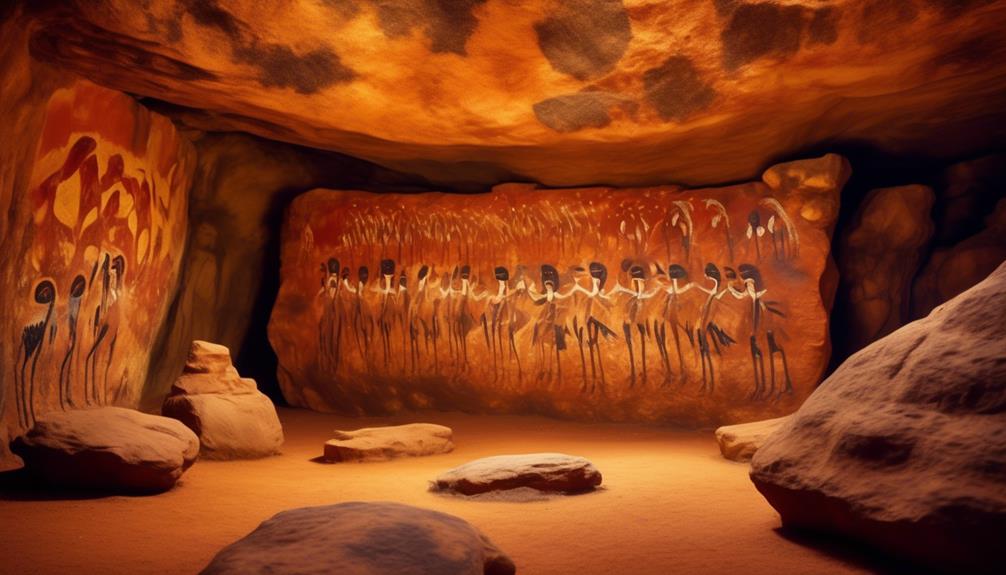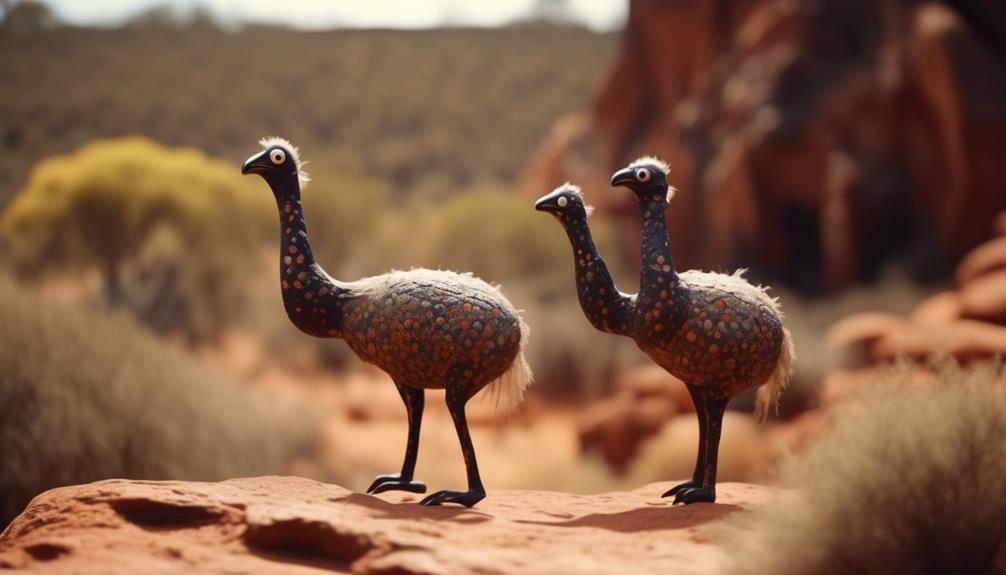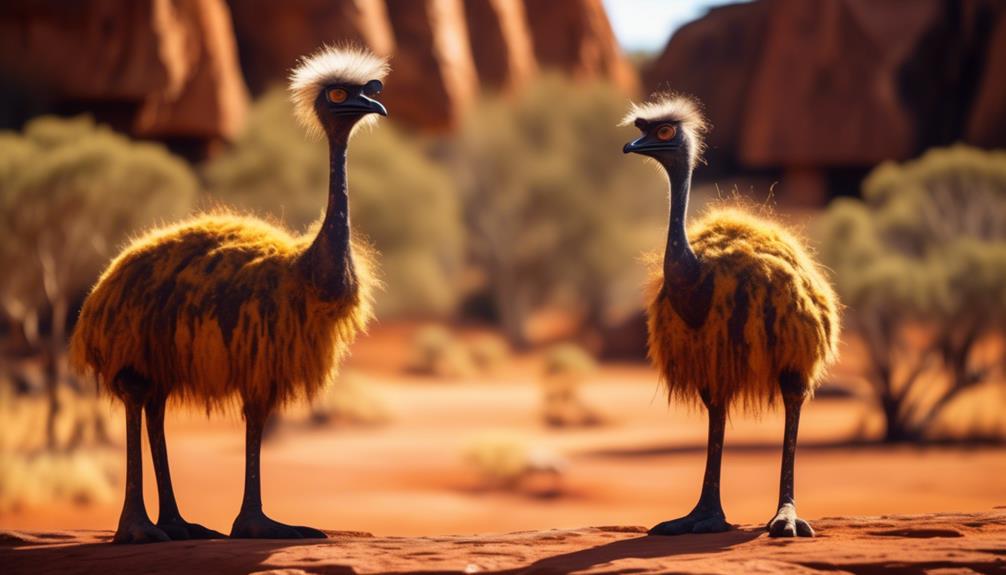
Imagine standing before a towering sandstone cliff, its weathered face adorned with vibrant ochre pigments that have withstood the test of time. As you gaze upon the ancient canvas, your eyes are drawn to the intricate depictions of emus, gracefully etched into the rock.
These magnificent birds, rendered with such skill and precision, hold a profound cultural significance for the Aboriginal people. But what do these emu representations truly symbolize? How were they created? And why are they so important to preserve?
Step into the world of ancient emu rock art, where a fascinating journey awaits, filled with mystery, symbolism, and a deep connection to the land.
Key Takeaways
- Emu rock art provides insights into the spiritual beliefs, cultural practices, and societal dynamics of Aboriginal communities.
- Emus were seen as a spiritual guide and symbol of strength and resilience.
- Emu rock art reflects the rich cultural heritage and deep spiritual connection with the emu.
- Emu rock art holds significant cultural value for Aboriginal communities, providing insights into ancient traditions, beliefs, and practices.
Cultural Significance of Emus in Aboriginal Rock Art
The cultural significance of emus in Aboriginal rock art is evident through the intricate depictions and symbolic representations found in these ancient artworks. Emus played a vital role in the lives of Aboriginal people, serving as a source of sustenance and a spiritual connection to the land.
Emu hunting practices were an essential part of Aboriginal culture, and this is reflected in the rock art. The depictions of emus often show hunters in action, using various strategies to capture these majestic birds. The attention to detail in these artworks showcases the knowledge and expertise of the Aboriginal people in emu hunting techniques.
Beyond their practical importance, emus held a spiritual significance for Aboriginal communities. They were seen as a spiritual guide and a symbol of strength and resilience. Aboriginal people believed that emus possessed a deep connection to the land and carried the wisdom of the ancestors. This spiritual connection is depicted in the rock art through the inclusion of sacred symbols and rituals associated with emus.
The cultural significance of emus in Aboriginal rock art provides a window into the rich heritage and beliefs of the Aboriginal people. These ancient artworks not only serve as a testament to their survival skills but also highlight the deep spiritual connection they had with the natural world.
Distribution and Diversity of Emu Representations
Emu representations in Aboriginal rock art exhibit a remarkable distribution and diversity, showcasing the extensive range of styles and techniques used by different Aboriginal communities across various regions. The depiction of emus in rock art provides valuable insights into the cultural significance of these birds and the importance of emu hunting in Aboriginal societies throughout history.
Here are four key aspects of the distribution and diversity of emu representations in Aboriginal rock art:
- Geographical Variation: Emu rock art can be found in different regions across Australia, reflecting the diverse habitats and cultural practices of Aboriginal communities. From the arid landscapes of central Australia to the coastal areas of the Kimberley, emu rock art is a testament to the deep connection between Aboriginal people and their environment.
- Styles and Techniques: Emu representations in rock art exhibit a range of artistic styles and techniques. Some artworks depict emus in a realistic manner, capturing their physical features with great detail, while others portray them in a more abstract or symbolic way. The use of different pigments, tools, and rock surfaces further contributes to the diversity of emu rock art.
- Emu Hunting Methods: Emu rock art provides insights into the hunting methods employed by Aboriginal communities. Some artworks depict scenes of people using spears or boomerangs to hunt emus, highlighting the importance of these birds as a source of food and resources.
- Rock Art Chronology: The dating of emu rock art allows us to understand the temporal aspects of Aboriginal culture and the changes that occurred over time. By analyzing the superimposition of different emu representations, archaeologists can establish a chronology of artistic styles and track the evolution of emu depictions in rock art.
Symbolism and Meanings Behind Emu Depictions

Symbolism and meanings behind emu depictions in Aboriginal rock art can provide valuable insights into the spiritual beliefs, cultural practices, and societal dynamics of Aboriginal communities throughout history. Emus hold significant cultural and spiritual importance for Aboriginal people, and their representations in rock art reflect this reverence.
Ritual practices surrounding emu depictions played a crucial role in Aboriginal communities. The emu was seen as a source of sustenance, and its depiction in rock art often served as a way to communicate information about hunting techniques, migration patterns, and the availability of food sources. These depictions weren't just artistic expressions but practical guides for survival.
The evolution of emu symbolism in Aboriginal rock art can be observed through the ages. Initially, emu representations were more naturalistic, depicting the physical features of the bird. However, over time, these depictions became more stylized and abstract, incorporating geometric patterns and symbols. This evolution suggests a deepening symbolism and a shift towards spiritual meanings.
Emu depictions also held social significance within Aboriginal communities. They were often associated with initiation ceremonies, where young men were taught important cultural and spiritual knowledge. The emu's symbolism represented strength, resilience, and adaptability, qualities that were highly valued in Aboriginal society.
Techniques and Styles Used in Emu Rock Art
As we explore the techniques and styles used in Aboriginal rock art depicting emus, we gain a deeper understanding of the intricate methods employed by these ancient artists to convey their spiritual and cultural beliefs. The emu, with its significance in Aboriginal culture as a symbol of strength, resilience, and survival, is depicted in various ways in rock art.
Here are four techniques and styles used in emu rock art:
- Realistic Depictions: Artists keenly observed the anatomy of emus and depicted them with great accuracy. From the long neck and slender body to the distinctive feathers and powerful legs, these representations showcase their meticulous attention to detail.
- Symbolic Elements: Emu hunting scenes in rock art often include symbolic elements to convey deeper meanings. For example, the use of dots and lines may represent tracks or footprints, symbolizing the emu's connection to the land and its importance in the Aboriginal way of life.
- Dynamic Poses: Emus are often depicted in dynamic poses, capturing their agility and grace. These fluid representations convey a sense of movement and energy, reflecting the artists' admiration for the emu's natural abilities.
- Layering and Overlapping: Artists employed layering and overlapping techniques to create depth and dimension in their rock art. This not only adds visual interest but also enhances the storytelling aspect, allowing the viewer to interpret the narrative of the emu hunting scenes.
Through these techniques and styles, Aboriginal rock art provides a window into the rich cultural heritage and deep spiritual connection that the Indigenous people have with the emu. It's a testament to their artistic prowess and their reverence for this remarkable bird.
Conservation and Preservation of Emu Rock Art Sites

To ensure the long-term preservation and conservation of the invaluable rock art sites depicting emus, comprehensive measures are implemented, combining scientific expertise, cultural sensitivity, and community involvement.
Conservation efforts for emu rock art sites rely heavily on archaeological research and community engagement. Through the collaboration of archaeologists, Indigenous communities, and government agencies, these sites are carefully studied and protected.
Archaeological research plays a crucial role in understanding the significance of emu rock art and its preservation. Experts conduct thorough surveys and excavations to document and analyze the sites, identifying any threats or deterioration. This scientific approach helps in developing effective conservation strategies tailored to each specific location.
However, conservation efforts also require community engagement to be successful. Indigenous communities hold valuable knowledge about the cultural significance of the emu rock art sites. Their involvement ensures that preservation efforts align with cultural protocols and traditions. Moreover, engaging local communities fosters a sense of ownership and responsibility, encouraging them to actively participate in the protection and management of these sites.
Frequently Asked Questions
How Many Different Species of Emus Are Represented in Aboriginal Rock Art?
In Aboriginal rock art, there are representations of different emu species. The significance of the emu in Aboriginal culture is profound, as it symbolizes fertility, survival, and a connection to the land.
Are There Any Specific Regions or Sites Where Emu Rock Art Is More Commonly Found?
You'll find emu rock art more commonly in regions with a strong Aboriginal presence. These representations hold great cultural significance, as emus symbolize spirituality, knowledge, and the connection between humans and the natural world.
How Do Aboriginal Communities Today Continue to Honor and Celebrate the Emu Through Art?
Aboriginal communities today continue to honor and celebrate the emu through art by using traditional Aboriginal art techniques. They create intricate and detailed emu representations, showcasing the cultural significance of the emu in their artwork.
Can the Age of Emu Rock Art Be Determined Through Scientific Dating Techniques?
Determining the age of ancient emu rock art is no easy feat. But fear not, for scientific dating techniques come to the rescue! With these methods, we can unlock the secrets of Aboriginal rock art.
Are There Any Specific Stories or Legends Associated With Emu Rock Art That Have Been Passed Down Through Generations?
There are specific stories and legends associated with emu rock art that have been passed down through generations. These representations hold deep cultural significance in Aboriginal communities and convey the symbolism of the emu.
Conclusion
In conclusion, the ancient emu representations found in Aboriginal rock art hold a profound cultural significance. These diverse and widespread depictions offer a glimpse into the symbolism and meanings attributed to the emu by Aboriginal communities.
The techniques and styles employed in these artworks showcase the artistic prowess of these ancient civilizations.
It's crucial to prioritize the conservation and preservation of these emu rock art sites to ensure the preservation of this valuable cultural heritage for future generations to appreciate and interpret.




